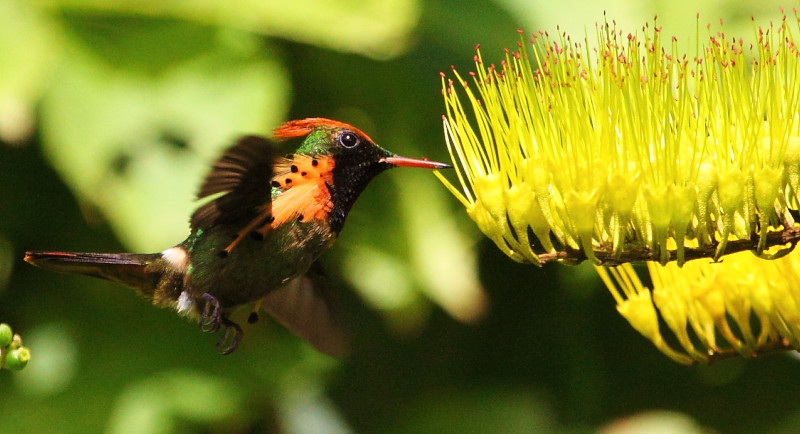
Tufted coquette Facts
- The appealing term of Tufted coquette serves as the accepted common name for a particularly vibrant variety of hummingbird. Professional ornithologists, however, know it better by its scientific name. That’s the hard to pronounce Lophornis ornatus.
- By whatever name you know it, though, it stands out from the majority of its related species. It also does so for several reasons. For one, it’s among the smallest of its kind, though not the tiniest. That distinction belongs to the Bee Hummingbird.
- This truly remarkable small avian also distinguishes itself from its peers in terms of sheer appearance. It possesses one of the most striking color patterns of any similar animals. But this works to its advantage in its native habitat.
- Its first recognition as a separate and distinct species occurred in 1781. This listing of its special status arose from the work of the noted French naturalist, Georges-Louis Leclerc Comte de Buffon. It appeared in his Histoire Naturelle des Oiseaux.
- For the moment, this tiny marvel of Nature appears to be maintaining a sufficient and stable population. This holds true throughout the entirety of its native range. As a result, the IUCN now lists it as Least Concern on its Red List of Threatened Species.
- The gorgeous Tufted coquette nonetheless does face certain potential threats to its existence. Firstly, the nature of its natural territory renders it vulnerable to the perils of habitat loss. Secondly, though, its greatest threat lies in the effects of climate change.
Related Articles
Tufted coquette Physical Description
The stunning Tufted coquette remains another of those creatures that prove that size has no bearing on beauty. Its appearance varies somewhat between the genders, however. That’s due to the fact that this bird displays a moderate degree of the trait of sexual dimorphism.
In the case of this specific bird, though, that principle manifests itself in ways other than sheer size. As a result, individuals of both sexes attain an average body length equaling roughly 2.6 in (6.6 cm). Each gender further averages around 0.08 oz (2.3 gm).
The gender-based differences appear in terms of physical attributes. That’s because the male has a rust-colored crest on its head that the female lacks. He also possesses small plumes of the same color projecting from his neck. The female however, lacks these as well.
Otherwise, both sexes of the Tufted coquette appear virtually identical. The upper portion of the body displays a coppery green, along with the stomach and forehead. The tail itself appears mainly a unique bronze-green. Precise shades in all areas vary by individual.
- Kingdom: Animalia
- Phylum: Chordata
- Class: Aves
- Order: Apodiformes
- Family: Trochilidae
- Genus: Lophornis
- Species: L. ornatus
Tufted coquette Distribution, Habitat, and Ecology
Fortunately for it and those who appreciate Nature, the Tufted coquette inhabits a broad range. That holds true when compared to related species, at least. That’s due to the fact that it evolved as native to a moderately wide area of the continent of South America.
More precisely, this magnificent bird inhabits the northern portions of that amazing continent. To the knowledge of researchers, it only lives in sections of four countries in that area. Those include the nations of Venezuela, Trinidad, Guiana, and northern Brazil.
Nevertheless, in all areas in which it appears, its populations remain quite scattered. Yet, thankfully, it appear to be adaptable. In fact, individuals make their homes in many different types of forests. Among these are regions of lowland and tropical rainforests.
Much like the many related birds, the stunning Tufted coquette mostly feeds on nectar. In its case, the animal feeds opportunistically on a wide range of flowering plants. But, it does show something of a preference for the blossoms of many flowering trees.
Individuals do occasionally modify their diet slightly, however. At such times, a few of them choose to also feed on various very small invertebrates. For the moment, the exact reason for this, much like some other facets of its life, continue to elude researchers.
After mating, the female constructs a small, cup-shaped nest. This she usually builds from down and twigs, and places on the branch of a tree. Uniquely, she almost always lays two eggs, with other numbers being exceeding rare. The reason for this also remains unknown.
Species Sharing Its Range
Check out our other articles on 4 Amazing North American Deserts, Velvet Belly lanternshark, Hogenakkal Falls, Purple Pitcher Plant, Chamois, Arrow-shaped micrathena, Saltwater Crocodile
